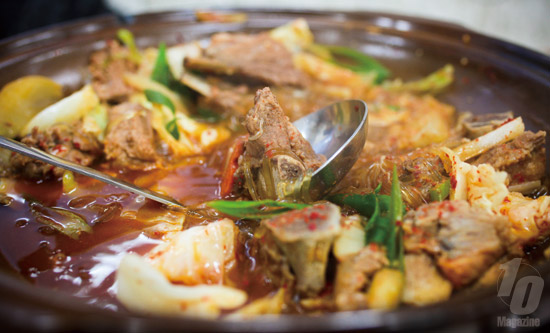Words by Ciaran Hickey, shot by Doug MacDonald
While galbi usually refers to grilled beef ribs served at a BBQ restaurant, galbi jjim is a comfort food akin to hearty beef stew.
In the cold of the Korean winter, there are few things as satisfying as a bowl of galbi jjim. Aside from the dates and chestnuts, this dish has to be the closest thing to what I would refer to as beef stew that you can find here. Back home, we serve it on mashed potatoes, but steamed rice works just as well for me.
The key ingredient that makes this dish a classic comfort food is the beef rib meat. It’s loaded with fat and when slow cooked with the seasonings it becomes tender and delicate, picking up the flavors from the other ingredients. The marbling of the fat varies greatly, so choosing the beef can be a time-consuming process.
Also, the meat is served still on the rib bones, giving the dish the appearance of a rustic, hearty dish that might be found on a farm. There’s nothing fancy about this dish—except the taste. The sweetness of the dish is cut by the vegetable and ginger flavors; I also like to sneak a chili or two into mine.
Galbi jjim is prepared by boiling the beef rib cubes in a large pot for about 30 minutes, removing any impurities. The meat is then boiled again in fresh water together with vegetables, herbs and spices to create a stock. After the meat is softened, it’s removed from the stock and the fat is skimmed from the surface. Next, the stock is mixed with soy sauce, sugar, rice wine, sesame oil, onion and pear which have all been blended together. The pear is there to add sweetness and help tenderize the meat.
At this point, the meat is returned to the sauce and simmered with a lid on until almost done. The dates and chestnuts are added for the last 20 minutes of slow cooking as the sauce reduces and concentrates. You can add your choice of vegetables to the dish: radishes, carrots, potatoes, ginko nuts
or mushrooms.
One of the secrets to galbi jjim’s tenderness is this half-braising, half-steaming cooking method which renders the fat in the meat down slowly. The finished dish can usually be served in the stone dish it’s cooked in. And there’s no better time than the cold depths of winter to experience this delicious slow-cooked treat.
Netizen’s Picks
[CLOSED] Kang Ho-dong 678 Jjim 강호동678찜
6+7+8=21. In Eastern philosophy, 21 represents wisdom and achievement. Korean celebrity Kang Ho-dong has certainly achieved success with his chain of galbi jjim restaurants. At the Apgujeong branch, choose from three kinds of galbi jjim: cheese, pepper, and a combination of the two. 636-16 Sinsa-dong, Gangnam-gu, Seoul. 02-517-0678
[CLOSED] Suwon Wondang Galbi 수원원당갈비
Galbi? Or galbi jjim? For those days when you just can’t decide, Suwon Wondong Galbi’s the place to go. Order a serving of galbi, and when you’re finished, they’ll fix up some spicy galbi jjim with the leftover ribs. 940-25 Ingye-dong, Paldal-gu, Suwon-si, Gyeonggi-do. blog.naver.com/wondanggalbi 031-226-6688
Nakyeong Jjim Galbi 낙영찜갈비
Turn up the heat on your galbi jjim experience at Daegu’s famous Dongin-dong jjim galbi alley. In addition to reversing the word order, jjim galbi gets spicy with the addition of red peppers and minced garlic. Start at Nakyeong Jjim Galbi, a restaurant favored by regulars at the alley. The Hanwoo (Korean beef) option is W25,000 a pop, but you won’t regret it. 297-1, Dongin-dong 1-ga, Jung-gu, Daegu. nakyoung.com 053-423-3330




